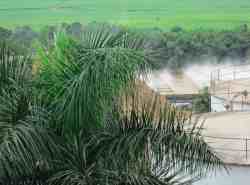 Oi from Brasil! I have spent the last three days learning about the ethanol industry in Brazil. I have been traveling with a group of 20 international journalists in the State of Sao Paulo, where 60 percent of the country’s sugarcane is grown and consequently where the majority of the ethanol is produced.
Oi from Brasil! I have spent the last three days learning about the ethanol industry in Brazil. I have been traveling with a group of 20 international journalists in the State of Sao Paulo, where 60 percent of the country’s sugarcane is grown and consequently where the majority of the ethanol is produced.
I’ll be writing a series of posts about my trip over the next week but I can sum up my experience in one sentence. Where there is a will, there’s a way. When the country of Brazil decided in the 1970s during the oil crisis that it would become energy independent, it did. Today, Brazil gets the majority of its energy, both renewable and fossil fuel based, within its boarders. In addition, the majority of the ethanol produced in the country stays in the country.
Also, unlike the U.S., Brazil produces most of its electricity needs from renewable sources as well. Today, more than 80 percent of its power comes from hydroelectricity, but this poses a problem during drought conditions and will be a bigger problem as water issues become more paramount. A solution? To sell the extra electricity from the sugar mills into the grid during the months the plants are operational, which happens to be during the dry time of the year. UNICA, the organization that represents the Brazilian sugarcane industry, predicts that sugarcane could supply 15 percent of the power by 2017.
While I don’t agree with all of Brazil’s polices and many in the country agree there have been some good and bad decisions, they offer the world demonstrable options and thus, a shorter learning curve to solid energy policies and technologies.
You can take a virtual tour via my Flickr account. Until tomorrow, Tchau.

